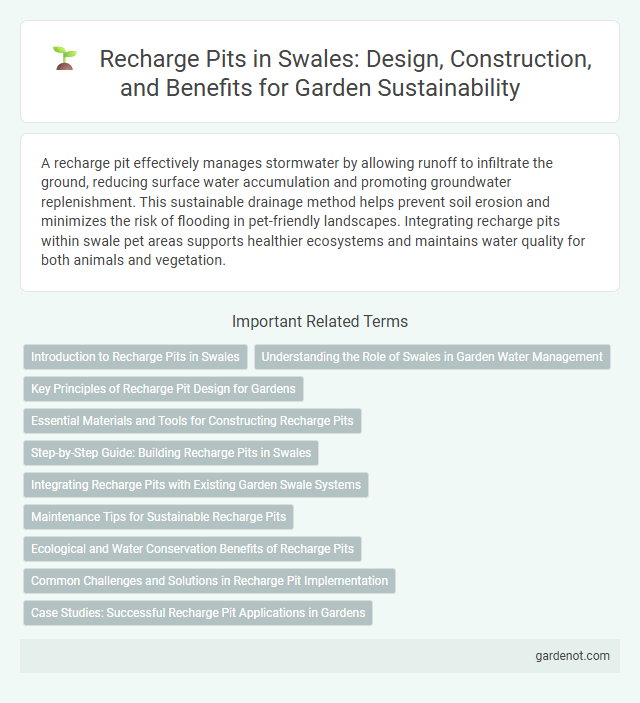A recharge pit effectively manages stormwater by allowing runoff to infiltrate the ground, reducing surface water accumulation and promoting groundwater replenishment. This sustainable drainage method helps prevent soil erosion and minimizes the risk of flooding in pet-friendly landscapes. Integrating recharge pits within swale pet areas supports healthier ecosystems and maintains water quality for both animals and vegetation.
Introduction to Recharge Pits in Swales
Recharge pits in swales are engineered depressions designed to capture and infiltrate stormwater runoff, enhancing groundwater recharge and reducing surface runoff. These pits are typically lined with permeable materials and filled with gravel or sand to facilitate water percolation into subsurface aquifers. Integrating recharge pits within swales improves stormwater management by mitigating flooding risks and promoting sustainable water resource management.
Understanding the Role of Swales in Garden Water Management
Swales play a critical role in garden water management by directing runoff into recharge pits, which facilitate groundwater infiltration and reduce surface water accumulation. Recharge pits beneath swales enhance soil moisture retention, promote healthy plant growth, and mitigate erosion by slowing water flow. Implementing swales alongside recharge pits optimizes rainwater harvesting and supports sustainable landscaping practices.
Key Principles of Recharge Pit Design for Gardens
Recharge pits in gardens enhance groundwater replenishment by capturing and infiltrating rainwater efficiently. Key principles include selecting permeable soil types, ensuring a proper pit size relative to catchment area, and incorporating filtration layers to prevent clogging. Positioning recharge pits away from tree roots and structures helps maintain garden health and pit functionality.
Essential Materials and Tools for Constructing Recharge Pits
Essential materials for constructing recharge pits include coarse sand, crushed stone, and geotextile fabric, which facilitate effective water percolation and filtration. Tools such as shovels, picks, wheelbarrows, and compactors ensure precise excavation and proper compaction of the pit base. Incorporating PVC pipes or perforated drain pipes enhances water inflow distribution and prevents clogging within the recharge pit system.
Step-by-Step Guide: Building Recharge Pits in Swales
Constructing recharge pits in swales involves excavating an appropriate-sized depression within the swale to facilitate water infiltration and groundwater recharge. Begin by identifying the ideal location along the swale where water naturally accumulates, then dig the pit to the recommended dimensions based on soil permeability and expected runoff volume. Line the pit with permeable materials such as gravel to prevent clogging, and backfill to promote efficient stormwater capture and reduce surface runoff.
Integrating Recharge Pits with Existing Garden Swale Systems
Integrating recharge pits within existing garden swale systems enhances stormwater management by increasing infiltration capacity and reducing surface runoff. Recharge pits strategically placed along swales capture excess water, promoting groundwater recharge while supporting vegetation health. This combination optimizes water retention and mitigates erosion, contributing to sustainable landscape design and resilient urban green infrastructure.
Maintenance Tips for Sustainable Recharge Pits
Regular inspection of recharge pits ensures accumulation of silt and debris is promptly removed, maintaining optimal water infiltration rates. Using a silt trap before the pit reduces sediment buildup and prolongs pit lifespan. Vegetation around the recharge pit should be managed to prevent root clogging while enhancing groundwater recharge efficiency.
Ecological and Water Conservation Benefits of Recharge Pits
Recharge pits enhance groundwater levels by facilitating rainwater infiltration into aquifers, reducing surface runoff and soil erosion. These structures support ecosystems by maintaining soil moisture and promoting vegetation growth, which in turn sustains local biodiversity. Recharge pits contribute significantly to water conservation efforts by replenishing groundwater resources, crucial for agricultural and domestic use during dry periods.
Common Challenges and Solutions in Recharge Pit Implementation
Recharge pits often face challenges such as clogging from sediment and organic matter, reducing infiltration efficiency and requiring regular maintenance to prevent waterlogging. Proper site assessment and the use of pre-filtration techniques like gravel layers or sedimentation chambers significantly improve pit performance by minimizing sediment entry. Implementing periodic cleaning schedules and vegetation management around recharge pits ensures sustained functionality and groundwater recharge rates.
Case Studies: Successful Recharge Pit Applications in Gardens
Recharge pits in garden settings have demonstrated effective groundwater replenishment by capturing and directing surface runoff into subsurface soil layers. Case studies reveal substantial improvement in soil moisture retention and increased availability of water for plant roots, reducing dependency on external irrigation. Strategic placement of recharge pits near garden perimeters enhances stormwater management and supports sustainable landscaping practices.
Recharge pit Infographic

 gardenot.com
gardenot.com